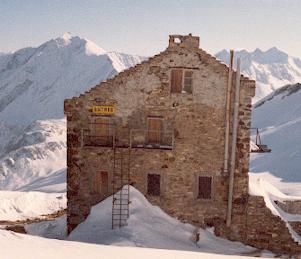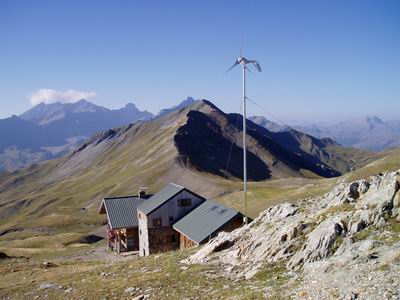
Going back in time…
One Summer, in the early seventies, as I was walking the TMB, I stopped by the great Croix du Bonhomme cairn.
There were three of us, trekking the old fashioned way, with our big back-packs full of the useful and the useless, as heavy to our shoulders as they looked, but consonant with those days ‘ideas. After a short pause by the stone marker we hurried directly to the Col des Fours and then Italy without meeting a soul alive, enjoying solitude, which is now a long gone memory.

In spite of the brevity of this pause, through the curve of the pass, we caught a glimpse of the Touring-Club de France refuge, sat on the neatly mowed Alpine meadow, lonely and stubbornly defying the assaults of the wind, proudly raising its decaying rough stone walls. Since 1924, right in the heart of the Alps, at the crossing between the Holland-Mediterranean GR5 and the TMB, it has welcomed hikers from different countries at 2,433 metres. Then, the war and men’s ill will relentlessly ruined it. The harsh weather, the rough high mountain conditions, the site isolation, combined with vandalism led to its dereliction. Yet, in 1965 a Franco-German work experience Scout camp, “SOS Bonhomme Operation”, salvaged it from falling completely into ruins. Then it was crudely refurbished by the TCF.
The official opening occurred in 1968 when the dining room was inaugurated.
I couldn’t imagine then that 10 years later, with Georges, Charles and Coco, we would be cleaning up this place which had left in my mind nothing but the image of a “TCF” roof. At the end of 1982, I learned that the Albertville Club Alpin Français was looking for a guardian for this Croix du Bonhomme refuge left open to draughts and dereliction. I applied and left the sea and ships which had been my first calling, working for the merchant navy. I must say that the Mont Blanc granite had often enticed me away from the Emerald coast and I had been considering working in the mountains for some time.
We found the building in a complete state of dereliction, with its broken windows and its rooms full of snow. Step by step, we discovered the damage: broken piping and stove, rotten mattresses and blankets, dishes and furniture either stolen or broken, a disheartening vision, a feeling of helplessness. Yet, even though it leaked, the roof wasn’t that shabby. Surprisingly enough, the wood panels and the staircases inside the building had kept their lustre and they still looked good.
We also came upon some graffiti engraved by the FFI (Forces Françaises de l’Intérieur) which marked their passage in this remote refuge one would have thought sheltered from conflicts. I am pretty sure none of those who were there in those days have forgotten these striking images, the state of disrepair the building was in, a year only after it had been abandoned.
Our venture started with the complete refurbishment of the refuge. In the beginning, we were a team of three guardians. No publicity, no reservations, no telephone, we managed to cope on a day to day basis. People already showed up, the trail was very busy, hikers stopped, happy to find this old refuge open. We improvised. Along the years we have gained more space wherever possible. We’ve even replaced the dorm doors with heavy curtains against the draughts to gain more space. In order to meet the demands of all the visitors, we’ve even turned the humid ground-floor stockroom into a dorm that one user has baptized “the Nordic”.

At peak periods, when bad weather conditions settle or when a thunder-storm bursts at the end of the day, the refuge is crowded and the atmosphere rather humid. There are clothes hanging all over the place. And security norms aren’t to be mentioned. Most users readily accept this rusticity and the lack of comfort, often amused or sympathizing to see us work in such basic and Spartan conditions. The kitchen is dark, with only one little window opening to the North. But it allows Coco, the mountain pastry cook, to prepare home-made cakes he can be proud of and which are always greeted with satisfaction when brought to the tables.
Of course, those who aren’t sound sleepers may be disturbed by the lack of privacy, the surrounding noise. Such was the case one night when a sturdy guy dashed in a fury into the dining room to tell off a musician friend and singer: “Hey you blasted sissy, with your accordion, shut that noise! And the one who’s singing, shut your face!” That put an end to the concert!
The attendance increases year by year. It is necessary to act. One day we promise me a new refuge. What will be made. The project of reconstruction takes shape and becomes clearer until the day when, unbelieving, not without difficulty and in three days we see going up an excavator to caterpillars which will give the kick-off of the construction site in July, 1990. The works are large-scale and, in agreement with André, we shall remain open during all the construction site. We assure with our ways the accommodation and the restoration of the walkers of passage, and the workers who wish for it.
Then in one day, the brick-layers built a cabin sleeping eight workers which caught fire one cold night. The foreman, they called him Tip-Top, slept in the same cabin and it was thanks to his composure that the fire was put out. The brick-layers were Turkish and according to Tip-Top they didn’t know how to use a fire extinguisher. Between them who were never wrong and their chief who was always right, the atmosphere was somewhat tense. They deserted the site with the first snowflakes.
The dining-room had been pulled down by the mechanical digger and we thought it would be a good idea to put up a Marabout tent to replace it temporarily. It was ever so temporary as it was crumpled in a few seconds by the work helicopter flying too close. A tent can be dangerous for a helicopter and the pilot may have deemed it better to rid the site of this unsightly annex. In spite of a few mistakes and blunders, the building went quickly and smoothly and the shell was finished in due time to allow everybody and the machinery that couldn’t spend winter up there to leave.
Including the crane that had been keeping us all worried at night in case of strong wind. The following summer, all professions of the building trade came to the site to complete the interior fittings. We lived in a bee-hive in which we managed a sort of rotating accommodation following the rooms under work. Three thousand people slept on the 1991 building site. A stop they can’t possibly have forgotten. And after a memorable period of work (Mark the water diviner!) from an old derelict building we stepped into this comfortable up-to-date building.
…to nowadays

But walkers haven’t changed that much and, in spite of our fears, they haven’t pestered us with urban requirements.
Ascending a few hours by foot, whether you are a statesman or a simple citizen, seems to make one more civilized.
The refuge is environment friendly since, apart from gas for cooking and making bread (André’s idea that solved the problem of the bread supply) every energy is solar powered : hot water, lighting, electricity, and keeping the flagstone from frost in winter.
In summer we have a small extra wind turbine. The site is well situated, exposed to winds ready to work for us.
The site was designed to resist winds blowing at 300 km an hour.
No noise pollution since we only use an electric generator in case of exceptional works and the windmill is at a distance.
All the better for us who live up there for three months ‘time!
The helicopter is only used except on the first and the last days, to carry goods, wood and gas, to rid us of specific garbage, such as glass and metal. We are happy to carry our loads all summer long. Each one of us in his turn, cheered and encouraged by hikers who ask “How many kilos ? What goods ? How often ?”. Once a day, not more, fresh food and reasonable loads, twenty to forty kilos. Sometimes, we borrow the shepherd’s, Pierre-Michel’s, long-eared beasts. When the male donkey, not castrated, brays, they immediately muster around him and the whole family climbs to the refuge, the female and her little ones.
Just like a vessel facing the open sea, the refuge dozes quietly during the long winter, welcoming the occasional skiers who, glad to find a pleasant abode, usually leave it clean. Then comes the summer upheaval. The Croix du Bonhomme is at a crossroads. We welcome and put up travelers some of whom are on their way for several weeks. We cater for them, give them some advice. They come in various ages, in groups or alone, guided or not, sometimes over equipped and sometimes under equipped. All sorts of people from all over the world.
Approaching Mont-Blanc on walking paths as well as crossing the Alps always strongly attract people. In July, we see mainly foreigners from Northern and Eastern Europe. The Japanese are also discovering the Tour du Mont-Blanc whereas relatively few Americans sleep at the refuge. This is due to their taste for more comfort that condemns them to spend the night at hotels in the valley. There, every evening, they find the vehicle that carries their luggage and their computer. Yet, they’ll never enjoy the crack of dawn in the mountains !
Others, less exacting regarding comfort, choose to have their luggage carried by mules and may stop off wherever they wish. We have a place for mules. We have set rings securely to prevent their munching voraciously on wooden shutters, tables and benches. Most of these hikers seem to enjoy a simple bliss far from their everyday life.
The most colourful ones are often loners, just like the little Jeanne, little but an immense adventurer back after a five-year trek and tribulations throughout Africa. Dropped by a plane at Roissy, she was on a health walk home in the Pyreneans via the Alps obviously, with a backpack as worn out as her shoes and not much of a luggage out of her unflinching morale. Or this anonymous pilgrim who had been walking briskly and steadily for five years too. He arrived singing, stopped for half-an-hour, told us his story briefly, showed us a paper signed by a bishop, his peace pilgrim viaticum. Back from Jerusalem, he was on his way to Portugal and Fatima, but had gone out of his way to North Cape for the equinox. It was a few years ago, in June, just when the refuge was being opened. By the time we went to the source to dig the snow and plug in the water, he was gone already.
Tristan Guyon



